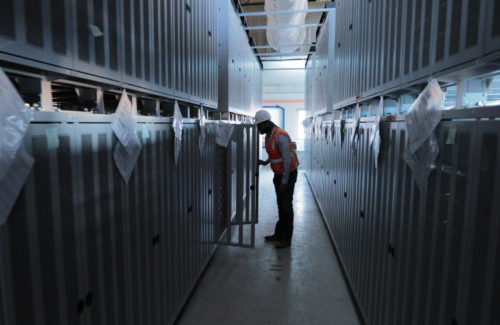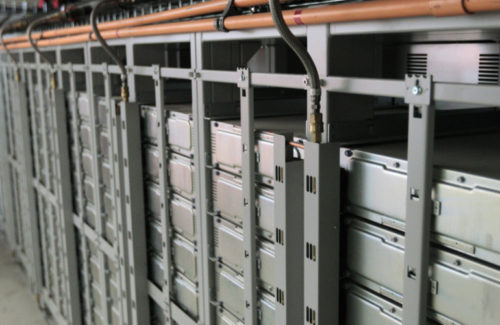The Moss Landing Energy Storage Facility, located just south of San Francisco, California, has been connected to the power grid and began storing energy on Dec. 11, 2020. At 300 MW/1,200 MWh, this lithium-ion battery-based energy storage system is likely the largest in the world. The system is located on-site at Vistra’s Moss Landing Power Plant.
Construction is already underway on Phase II, which will add an additional 100 MW/400 MWh to the facility by August 2021, bringing the site’s total storage capacity to 400 MW/1,600 MWh.
“This is a keystone project and it is important in so many ways – it revitalizes an existing power plant site and utilizes active transmission lines, enhances grid stability, fills the reliability gap created by intermittent renewables, provides emission-free electricity, supports California’s sustainability goals and mandates, significantly benefits the local community, and ultimately provides affordable electricity to consumers,” said Curt Morgan, chief executive officer of Vistra. “A battery system of this size and scale has never been built before. As our country transitions to a clean energy future, batteries will play a pivotal role and the Vistra Moss Landing project will serve as the model for utility-scale battery storage for years to come.”
Housed inside the power plant’s completely refurbished former turbine building and spanning the length of nearly three football fields, Phase I of the battery system is made up of more than 4,500 stacked battery racks or cabinets, each containing 22 individual battery modules, which capture excess electricity from the grid, largely during high solar-output hours, and can release the power when energy demand is at its highest and solar electricity is declining, usually early morning and late afternoon.
Phases I and II of the Vistra Moss Landing Energy Storage Facility are backed up by long-term resource adequacy contracts with Pacific Gas and Electric Company (PG&E).
“We appreciate the strong working relationship we’ve developed with PG&E on multiple projects and look forward to continuing to help meet its resource adequacy requirements and provide clean, reliable, and affordable power to Californians,” Morgan said.
 Vistra’s Moss Landing site provides a unique opportunity for extensive future expansion of the battery system. With its existing infrastructure and the physical space for potential growth, this industrial-zoned site can support up to 1,500 MW/6,000 MWh of storage capacity should market and economic conditions support it. With the development permit already in place and the site in condition for expansion, Vistra will be able to move quickly when that time comes.
Vistra’s Moss Landing site provides a unique opportunity for extensive future expansion of the battery system. With its existing infrastructure and the physical space for potential growth, this industrial-zoned site can support up to 1,500 MW/6,000 MWh of storage capacity should market and economic conditions support it. With the development permit already in place and the site in condition for expansion, Vistra will be able to move quickly when that time comes.
News item from Vistra







Was there a second over-heating incident at the Moss Landing facility last night? I’m about 7 miles from the Elk Horn Slough which borders this facility. It’s in the Monterey Bay Marine Sanctuary. How safe is it to be this close to this bomb?
Thanks for sharing such a useful information. Shall indeed be grateful if the following information is provided:-
1. What is the largest battery pack size which is providing electricity to grid anywhere in the world?
2. What is the battery pack unit cost and also the overall cost per kWh for providing the electricity?
3. For what maximum period the battery pack could provide electricity before it is to be charged again? How much time is taken to recharge?
4. Believe the electricity being drawn from batteries is not commercially viable for such utility-grade applications as the cost of supplying power in USA on an average is 10.50 Cents/kWh whereas from Li-Ion battery pack it is of the order of $132/kWh in 2021 viz. 1,257 times which is quite exorbitant!
5. By what time roughly in which year the parity is likely to be achieved between grid power supply cost and battery storage power?
6. The cost comparison is to be made taking into consideration social and environmental impacts also or the cost of supply from the battery pack?
7. Since it might take lot of time in making the electric supply from storage batteries commercially viable and to achieve parity with grid supply, then whether the world should continue adding renewable capacities at a fast pace? It is feared that in the absence of viable storage means the intermittent supplies from renewable sources might be a reason for grid instability
Best Regards
We must expect an increasing frequency of fire and explosion hazard as battery storage increases worldwide. Coal-fired power plants in the US maintain an energy storage of typically 100 days, in the form of coal. Fires do occur, but are limited by the separation of the reductant from its oxidant, air. Not so limited, a battery farm storing a similar bad-season’s-worth of electric power would contain 100 GW-days or 86.4 TJ, which is the energy equivalent to 20,000 tons of TNT.
The current fire in Morris Illinois and fire in Arizona two years ago of lithium batterie storage facility and the fire departments inability to put that fire out should be concerning to all. Local residents were evacuated because of hazardous fumes while not knowing if they will return home in a week, two weeks or whatever. Local officials tell citizens, if you can smell get away fast. Fires linked to lithium-ion batteries also have hit Europe and Australia. Hazmat teams members have been seriously injured in these fires. In Arizona fire, at the moment of the deflagration event, the firefighters outside the hot zone described hearing a loud noise and seeing a jet of flame that extended at least 75 ft outward and an estimated 20 ft vertically from the southeast-facing door.
“Construction is already underway on Phase II, which will add an additional 100 MW/400 MWh to the facility by August 2021, bringing the site’s total storage capacity to 400 MW/1,600 MWh.”
Wow, heard about the Moss Landing plant changing from natural gas turbines to energy storage about two years ago. I believe the really big battery, the Elkhorn project between Vistra and PG&E will be the 1,500MW/6,000MWh project next. As PG&E is the primary share holder of the soon to be decommissioned Diablo Canyon nuclear plant by 2025, I’m thinking this project will be online sooner than later. Like the miniscule TESLA battery installed in Australia in 2017 that was 100MW/129MWh, which actually paid for itself in ancillary grid services in about 2.5 years, it will be interesting to see how this asset amortizes during use over the next few years. An aside: The so called big battery in Australia has already been built up to 150MW/193.5MWh with just 3 years in operation. There have been some proof of concept energy storage systems out in the field for almost or right at 10 years of in service use. Pretty soon we should be getting news of, if these assets still have plenty of useful life remaining in the ESS or will there have to be new systems or new batteries installed to continue on? The electric utility industry has years of experience and data on rotating mass, commodity fueled generation resources. Battery storage and electronic switching inverter technology is still new as operations and maintenance are derived for the long term use of the technology. Things like how long does the batteries last? What if you do what TESLA does and have a fluid heat transfer system as part of the battery pack? When the batteries degrade to the industry point of 80% capacity, are these assets still useful in some grid services for years after the 10 year design period?
Energy storage will dramatically transform the solar landscape in the coming decades. This facility will serve as a great test bed and example of the potential of battery storage.